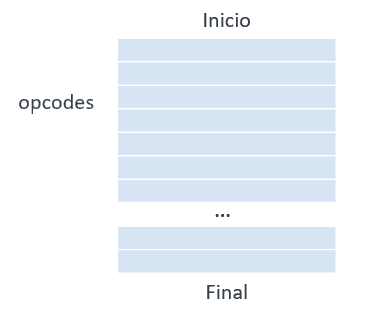Machine code is a VERY low-level programming language that is directly executable by the central processing unit (CPU) of a computer.
If we open an executable program, we will see a jumble of data like the following (but with many, many, many more lines)
00 F3 0F 6F 05 D7 8E 06 00 0F 11 74 24 60 0F 11 44 24 70 41 80 FD 03 0F 84
9B 03 00 00 8B 7E 04 45 31 F6 85 FF 0F 89 AF FD FF FF 80 7E 08 00 0F 84 DB
02 00 00 31 FF 41 80 FD 01 40 0F 94 C7 83 C7 06 E9 AD FD FF FF 66 0F 1F 84
00 00 00 00 00 80 7C 24 6F 01 0F 84 3D 04 00 00 8B 44 24 60 48 83 F8 03 0F
86 5A 02 00 00 BA 03 00 00 00 E9 0E FF FF FF 0F 1F 44 00 00 40 84 ED 48 8D
3D 43 84 06 00 48 8D 05 40 84 06 00 48 0F 45 F8 E9 C8 FE FF FF 66 0F 1F 44
00 00 45 84 F6 0F 84 17 03 00 00 45 0F B6 F6 48 8D 05 BC 83 06 00 48 C7 44
24 70 01 00 00 00 41 BD 01 00 00 00 42 0F B6 04 30 88 84 24 80 00 00 00 48
8D 44 24 50 48 89 44 24 30 66 0F EF F6 C6 44 24 50 25 44 8B 76 04 48 8D 54
24 51 F3 0F 5A F1 40 84 FF 74 0A C6 44 24 51 23 48 8D 54 24 52 45 85 F6 78
0F 0F B7 05 12 8E 06 00 48 83 C2 02 66 89 42 FE 40 80 FD 01 C6 42 01 00 BF
F4 01 00 00 4C 89 FB 19 C0 83 E0 20 83 C0 41 88 02 49 8D 45 01 48 89 44 24
38 0F 1F 00 4C 29 EF 4A 8D 0C 2B 48 89 FD 45 85 F6 0F 88 A4 00 00 00 4C 8B
44 24 30 F2 0F 11 74 24 20 45 89 F1 48 89 FA E8 17 F4 FE FF 48 8B 7C 24 78
48 8B 5C 24 68 85 C0 0F 88 A4 00 00 00 48 98 48 39 E8 0F 82 EA 00 00 00 48
8B 54 24 38 48 01 D0 48 39 C7 73 AD 48 89 FD 48 D1 ED 48 01 FD 48 39 C5 48
(... many, many, many more lines)What is that? That is machine code, that is, the binary code necessary for your processor to execute the program. This is the only language your processor understands.
Each instruction corresponds to a specific basic operation that the CPU can execute. These are very basic and simple operations (for example, adding two numbers, transferring data from one place to another in memory, or comparing two numbers).
The available instructions vary between architectures and models of processors. An old x86 8088 had 81 instructions. A modern processor can have several hundred instructions available.
Machine code uses the basic instructions by calling them by their “operation code” (opcode, which is simply a numerical representation we give to each instruction).

As we can see, machine code is totally dependent on the underlying hardware. Each processor has its own set of instructions, its opcodes, and its own register structure.
This means that machine code written for a specific processor architecture is not directly compatible with another different processor. That bunch of bytes will only work on a processor of one type.
Another obvious feature of machine code is that its readability for humans is very low. It consists of a sequence of zeros and ones, making it very difficult for humans to understand and maintain. Furthermore, machine code lacks the abstractions and advanced control structures found in high-level programming languages.
Although it may seem unbelievable, in the early days of programming, people programmed like this. And as you can imagine, it was a nightmare to program in that. It was a very slow, complicated, and error-prone process. That is why other languages, such as Assembly, soon emerged that made the process easier.
Although machine code is considered (and is) a low-level programming language, its direct use in modern application development is very limited (or one could say practically nil).
Today, most programmers use high-level programming languages, such as C++ or Python, which offer friendlier abstractions and control structures for software development.